13 Of The Best Plants To Grow In Your Kitchen
Here are the best houseplants for your kitchen.
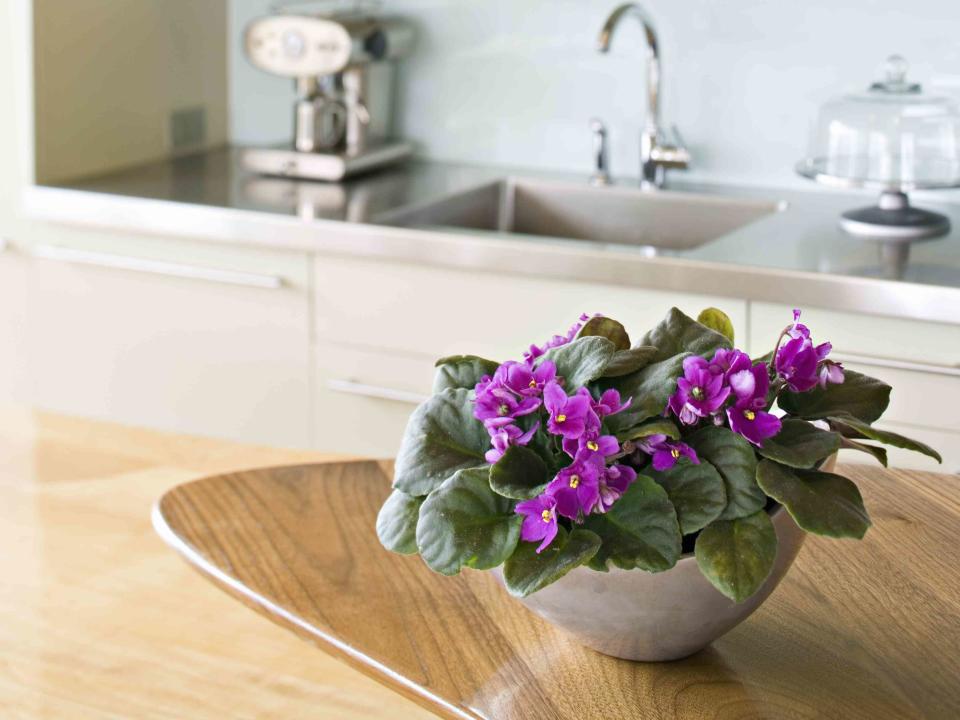
Getty Images
Fact checked by Khara Scheppmann
If your kitchen could use an update, add a houseplant or two. Every home looks (and feels!) better with live greenery. Just like bedroom plants, kitchen plants add instant style and livability to the space. Many types of houseplants also adapt to low light levels if your kitchen isn’t blessed with big, sunny windows.
The first step is to figure out a good location for your plant. A small LED grow light works for windowless or dark kitchens. Also, be practical: You don’t want to have to shift a potted plant out of the way every time you’re unloading groceries or slicing and dicing. A shelf, an unused corner of the countertop, or hanging pots are display options that keep your plant close but out of your way.
To keep your plant healthy, don’t overwater it. The only way to tell if a plant needs a drink is to poke your finger into the soil an inch or two. If the soil sticks to your finger, it probably doesn’t need watering yet. Wait another day or two and check again. Always err on the side of a little too dry than too wet because more houseplants die from overwatering than underwatering.
Ahead, our baker’s dozen (of course!) of the best plants for your kitchen:
Baltic Blue Pothos

Costa Farms
Botanical name: Epipremnum pinnatum ‘Baltic Blue’
Light: Bright, indirect light but can adapt to moderate light levels
Water: Water when top inch or two of soil feels dry; does not tolerate soggy soil
This pothos is a real stunner! Baltic Blue pothos has a handsome blue cast with leaves that fenestrate, or develop slits in the sides, as it matures. It’s just as easy to grow as more common forms of pothos so it’s a great plant for novices.
Heartleaf Philodendron
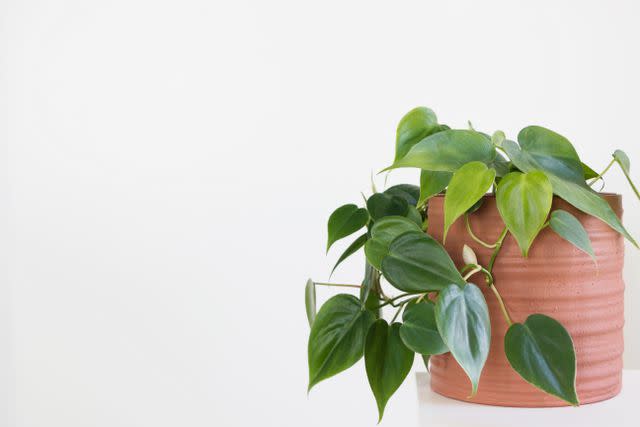
Getty Images
Botanical name: Philodendron hederaceum
Light: Medium to bright indirect light but can adapt to lower light levels
Water: Water when the top few inches of soil feels dry
Philodendrons are super easy to grow. This type has shiny heart-shaped leaves and a vining form. It’s not fussy and adapts well to low light levels. Heartleaf philodendron is another good choice for first-time plant parents.
Olive Tree

Getty Images
Botanical name: Olea europaea
Light: Direct sun, 6 to 8 hours per day
Water: Water when soil dries out a few inches down; does not tolerate soggy soil
Looking for something a little different? This Mediterranean native is a natural in your kitchen! They’re not difficult to grow if they get sufficient light. There are non-fruiting types and fruiting types, which bear olives. Although it’s unlikely you’ll get olives (olive plants require a chill period to stimulate flowering and set fruit), the silvery-green foliage make this an attractive plant for any sunny kitchen.
Snake Plant

Getty Images
Botanical name: Dracaena trifasciata, previously Sansevieria trifasciata
Light: Low to moderate light
Water: Water every few weeks when top few inches of soil feels dry
If your kitchen is on the dark side, you still can enjoy the striking shape of this hardy plant. Snake plants thrive on neglect, tolerate low light levels, and hardly ever need to be watered. It’s available in many different varieties and is ideal for adding greenery that won’t need to be babied.
Aloe Vera Plant
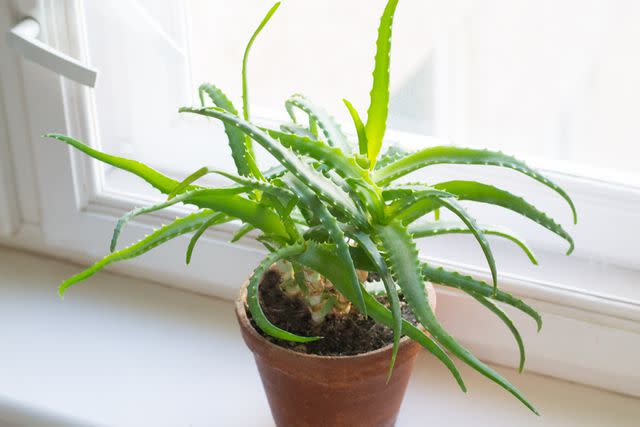
Getty Images
Botanical name: Aloe vera
Light: Bright, indirect light
Water: Water every 1 to 2 weeks when the soil feels mostly dry; does not tolerate soggy soil
The fleshy green leaves of aloe vera retain moisture, so it’s great for new plant parents or if you sometimes forget to water. Some varieties have an interesting texture with red bumps or white speckles. Aloe vera actually contains compounds that contain anti-inflammatory and anti-microbial properties, and some studies show it may shorten the duration of wound healing.
Coffee Plant

Getty Images
Botanical name: Coffea arabica
Light: Bright, indirect light but not direct sunlight, which will scorch the leaves
Water: Water when the top inch or two of soil feels dry
Yes, this is the same plant from which coffee beans are harvested! You’ll love this plant’s super-shiny green leaves and bushy form, which stays nice and compact. Sometimes, coffee plants produce a few fragrant white flowers in the spring, though it likely won’t yield beans. However, it’s a definite conversation starter for your kitchen countertop.
Jade Plant
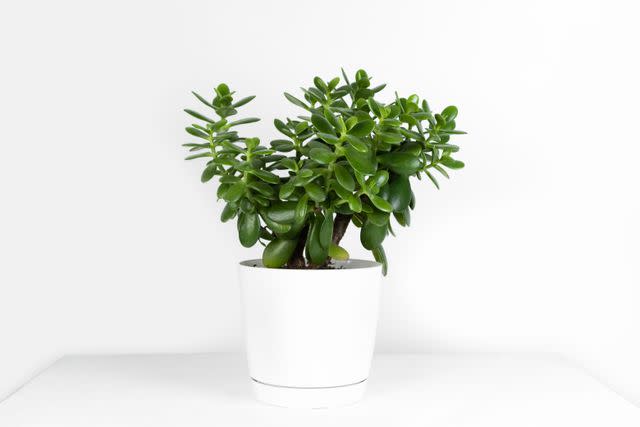
Getty Images
Botanical name: Crassula ovata
Light: Bright, indirect light
Water: Water every two weeks (or less); does not tolerate soggy soil
With fat, shiny oval leaves and a cute mini “tree” form, these are appealing plants for the kitchen. These succulents are slow-growers and don’t mind being root-bound, so they don’t take up a ton of space and you won’t have to fuss over them. The fastest way to kill jade plants is by overwatering them; make sure they dry out before giving them another drink.
African Violet
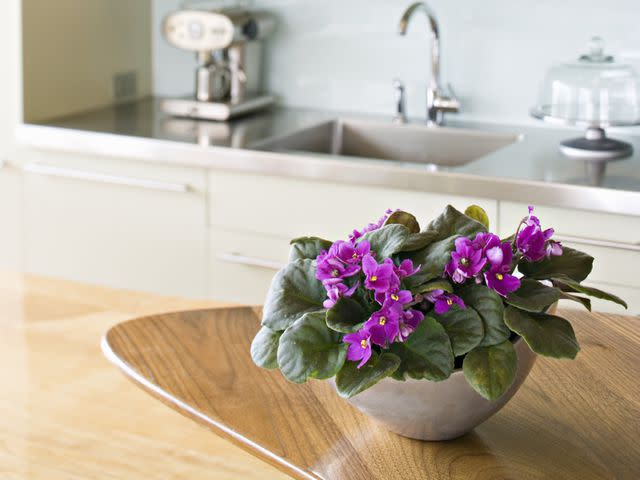
Getty Images
Botanical name: Streptocarpus ionanthus
Light: Bright, indirect light
Water: Water from the bottom, setting it in a basin to soak up water for 30 minutes, when the soil surface feels slightly dry to the touch
These old-school favorites bloom all year long under the right growing conditions. There are thousands of named varieties with single, ruffled, or double-petaled blooms in colors ranging from soft pink to pure white, lavender, and purple-blue. African violets are an inexpensive way to dress up a windowsill, but keep them out of direct sunlight, which can scorch their leaves.
Cast Iron Plant
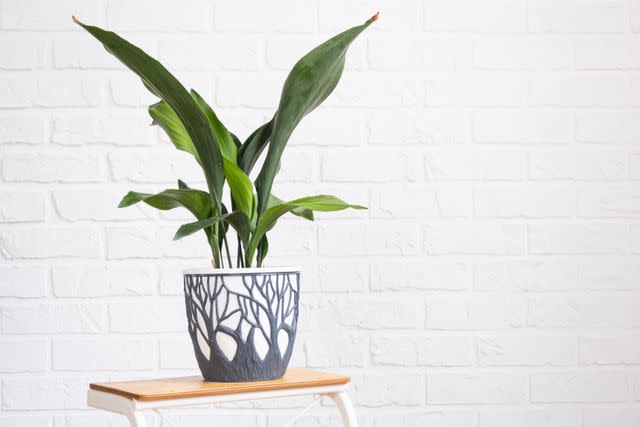
Getty Images
Botanical name: Aspidistra elatior
Light: Low to moderate light
Water: Water when top inch or two of soil feels dry
Cast iron plant earns its name: It’s almost indestructible! With long, strappy leaves and an upright form, it makes a handsome addition to low light corners of the kitchen. Some varieties have speckled leaves.
Birkin Philodendron

Getty Images
Botanical name: Philodendron ‘Birkin’
Light: Bright, indirect light
Water: Water when top inch of soil feels dry; does not tolerate soggy soil
The creamy pin-striped foliage of this plant make it an eye-catching addition to your kitchen. Birkin is a relatively slow-growing philodendron variety that stays fairly compact and bushy, so it’s ideal in small spaces.
Air Plant
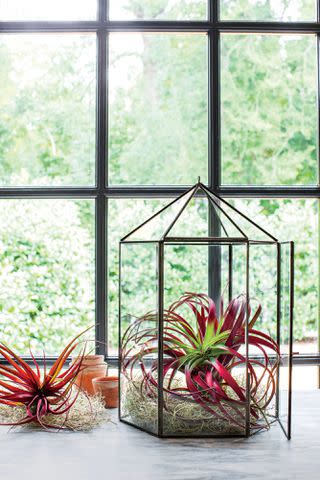
Botanical name: Tillandsia
Light: Bright, indirect light
Water: Dunk and drip-dry (see detailed instructions below)
Display these unusual plants in hanging glass globes, baskets or on wooden stands. There are two basic types of air plants: “Xeric,” which have silver, flat leaves with a fuzzy-looking texture; they grow in desert climates. “Mesic” types have dark green leaves that are curled or cupped; they grow in humid habitats, under the forest canopy. Water xeric types by dunking in water, then shaking out and letting dry before replacing in its display vessel. Mesic types should be soaked about once a week in a bowl for 20 to 30 minutes, then let it dry before placing it back in the holder.
Hurricane Fern
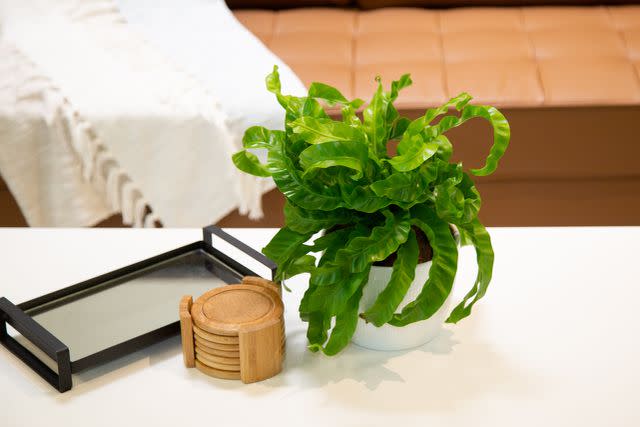
Costa Farms
Botanical name: Asplenium ‘Hurricane’
Light: Bright, indirect light
Water: Water when top of the soil feels dry to the touch, typically two to three times per week
If you have your heart set on a fern, opt for hurricane fern, which is a type of bird’s nest fern. It has thick, wavy, whirling fronds which retain water. That means it’s less fussy than many other types of ferns, which tend to be messy and drop fronds in a dry indoor environment.
Silver Streak Pothos
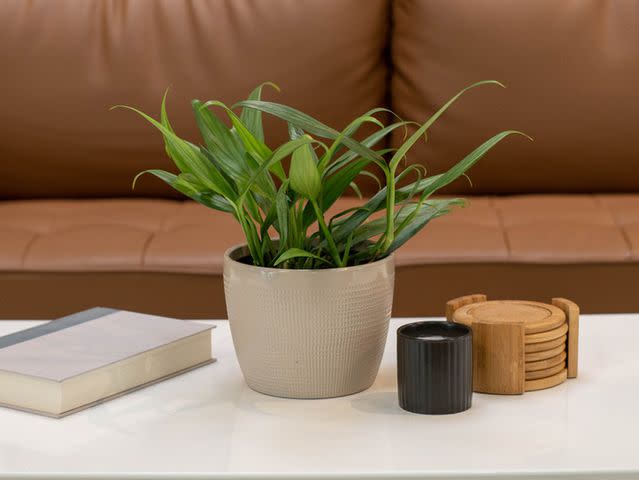
Costa Farms
Botanical name: Epipremnum amplissimum
Light: Bright, indirect light
Water: Water when the top half of the potting soil feels dry to the touch
You’d never know this is a pothos because, unlike many other types, it has a more upright form than a vining form. It has long strappy leaves with silver streaks that become more prominent in higher light levels. Silver Streak pothos can climb to six feet if given a moss pole for support.
For more Southern Living news, make sure to sign up for our newsletter!
Read the original article on Southern Living.

